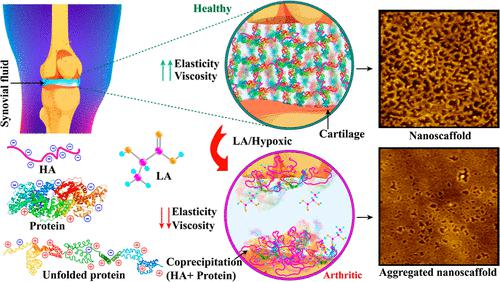当前位置:
X-MOL 学术
›
ACS Biomater. Sci. Eng.
›
论文详情
Our official English website, www.x-mol.net, welcomes your feedback! (Note: you will need to create a separate account there.)
Lactic Acid-Induced Colloidal Microrheology of Synovial Fluids
ACS Biomaterials Science & Engineering ( IF 5.8 ) Pub Date : 2024-03-22 , DOI: 10.1021/acsbiomaterials.3c01846 Nayanjyoti Kakati 1 , Dileep Ahari 2 , Prathu Raja Parmar 1 , Omkar Suresh Deshmukh 1 , Dipankar Bandyopadhyay 1, 3, 4
ACS Biomaterials Science & Engineering ( IF 5.8 ) Pub Date : 2024-03-22 , DOI: 10.1021/acsbiomaterials.3c01846 Nayanjyoti Kakati 1 , Dileep Ahari 2 , Prathu Raja Parmar 1 , Omkar Suresh Deshmukh 1 , Dipankar Bandyopadhyay 1, 3, 4
Affiliation

|
The presence of colloidal scaffolds composed of proteins and hyaluronic acid engenders unique viscous and elastic properties to the synovial fluid (SF). While the elastic resistance of SF due to the presence of such nanoscale structures provides the load-bearing capacity, the viscous nature enables fluidity of the joints during the movements to minimize the wear and tear of the adjacent muscle, cartilage, or bone tissues. It is well-known that the hypoxic conditions at the bone joints often increase the lactic acid (LA) concentration due to the occurrence of excess anaerobic respiration during either hyperactivity or arthritic conditions. The present study uncovers that in such a scenario, beyond a critical loading of LA, the colloidal nanoscaffolds of SF break down to precipitate higher molecular weight (MW) proteins and hyaluronic acid (HA). Subsequently, the viscosity and elasticity of SF reduce drastically to manifest a fluid that has reduced load bearing and wear and tear resistance capacity. Interestingly, the study also suggests that a heathy SF is a viscoelastic fluid with a mild Hookean elasticity and non-Newtonian fluidity, which eventually transforms into a viscous watery liquid in the presence of a higher loading of LA. We employ this knowledge to biosynthesize an artificial SF that emulates the characteristics of the real one. Remarkably, the spatiotemporal microscopic images uncover that even for the artificial SF, a dynamic cross-linking of the high MW proteins and HA takes place before precipitating out of the same from the artificial SF matrix, emulating the real one. Control experiments suggest that this phenomenon is absent in the case when LA is mixed with either pure HA or proteins. The experiments unfold the specific role of LA in the destruction of colloidal nanoscaffolds of synovia, which is an extremely important requirement for the biosynthesis and translation of artificial synovial fluid.
中文翻译:

乳酸诱导的滑液胶体微流变学
由蛋白质和透明质酸组成的胶体支架的存在使滑液(SF)具有独特的粘性和弹性特性。虽然由于这种纳米级结构的存在而产生的 SF 的弹性阻力提供了承载能力,但粘性特性使关节在运动过程中具有流动性,从而最大限度地减少邻近肌肉、软骨或骨组织的磨损。众所周知,由于在多动或关节炎情况下发生过度无氧呼吸,骨关节的缺氧条件通常会增加乳酸(LA)浓度。本研究发现,在这种情况下,除了 LA 的临界负载之外,SF 的胶体纳米支架会分解,沉淀出较高分子量 (MW) 的蛋白质和透明质酸 (HA)。随后,SF的粘度和弹性急剧降低,表现为承载能力和抗磨损能力降低的流体。有趣的是,该研究还表明,健康的 SF 是一种具有温和胡克弹性和非牛顿流动性的粘弹性流体,在 LA 负载量较高的情况下最终会转化为粘性水状液体。我们利用这一知识来生物合成一种人造 SF,模仿真实的 SF 的特征。值得注意的是,时空显微图像揭示,即使对于人造 SF,高分子量蛋白和 HA 也会在从人造 SF 基质中沉淀出来之前发生动态交联,模拟真实的蛋白。对照实验表明,当 LA 与纯 HA 或蛋白质混合时,这种现象不存在。实验揭示了LA在破坏滑液胶体纳米支架中的具体作用,这是人工滑液生物合成和翻译的极其重要的要求。
更新日期:2024-03-23
中文翻译:

乳酸诱导的滑液胶体微流变学
由蛋白质和透明质酸组成的胶体支架的存在使滑液(SF)具有独特的粘性和弹性特性。虽然由于这种纳米级结构的存在而产生的 SF 的弹性阻力提供了承载能力,但粘性特性使关节在运动过程中具有流动性,从而最大限度地减少邻近肌肉、软骨或骨组织的磨损。众所周知,由于在多动或关节炎情况下发生过度无氧呼吸,骨关节的缺氧条件通常会增加乳酸(LA)浓度。本研究发现,在这种情况下,除了 LA 的临界负载之外,SF 的胶体纳米支架会分解,沉淀出较高分子量 (MW) 的蛋白质和透明质酸 (HA)。随后,SF的粘度和弹性急剧降低,表现为承载能力和抗磨损能力降低的流体。有趣的是,该研究还表明,健康的 SF 是一种具有温和胡克弹性和非牛顿流动性的粘弹性流体,在 LA 负载量较高的情况下最终会转化为粘性水状液体。我们利用这一知识来生物合成一种人造 SF,模仿真实的 SF 的特征。值得注意的是,时空显微图像揭示,即使对于人造 SF,高分子量蛋白和 HA 也会在从人造 SF 基质中沉淀出来之前发生动态交联,模拟真实的蛋白。对照实验表明,当 LA 与纯 HA 或蛋白质混合时,这种现象不存在。实验揭示了LA在破坏滑液胶体纳米支架中的具体作用,这是人工滑液生物合成和翻译的极其重要的要求。



























 京公网安备 11010802027423号
京公网安备 11010802027423号